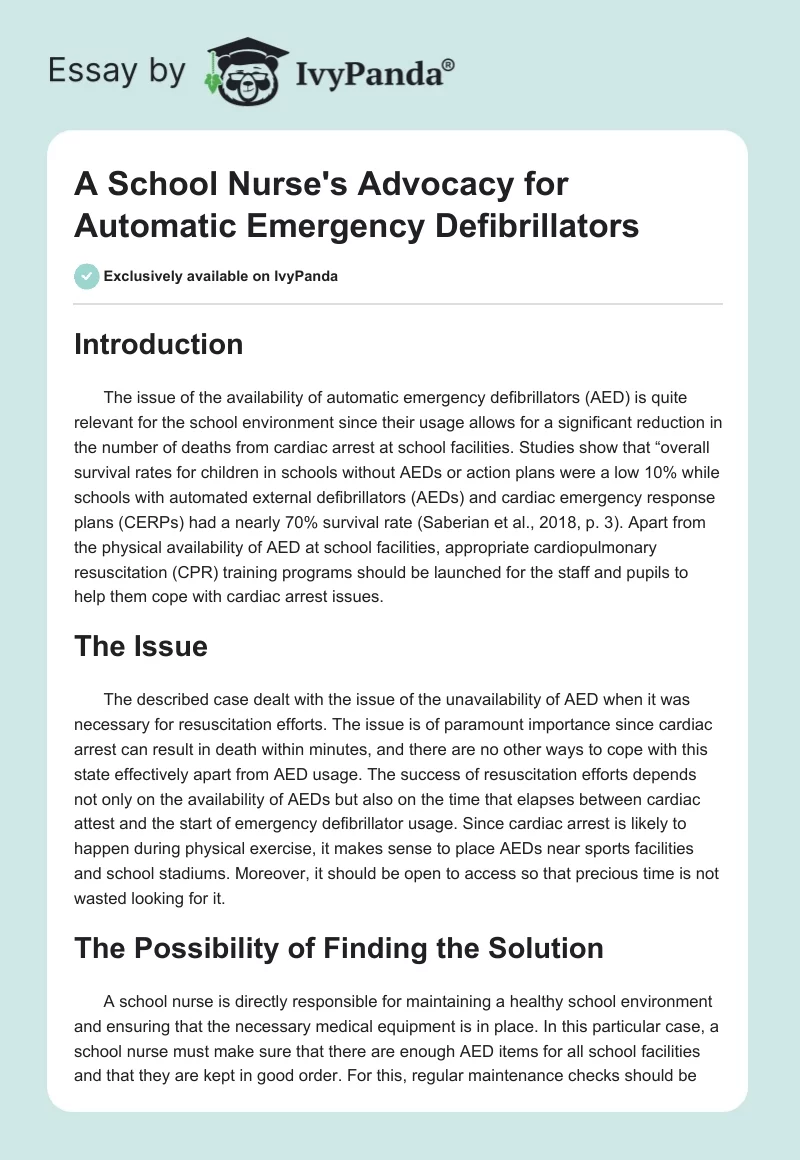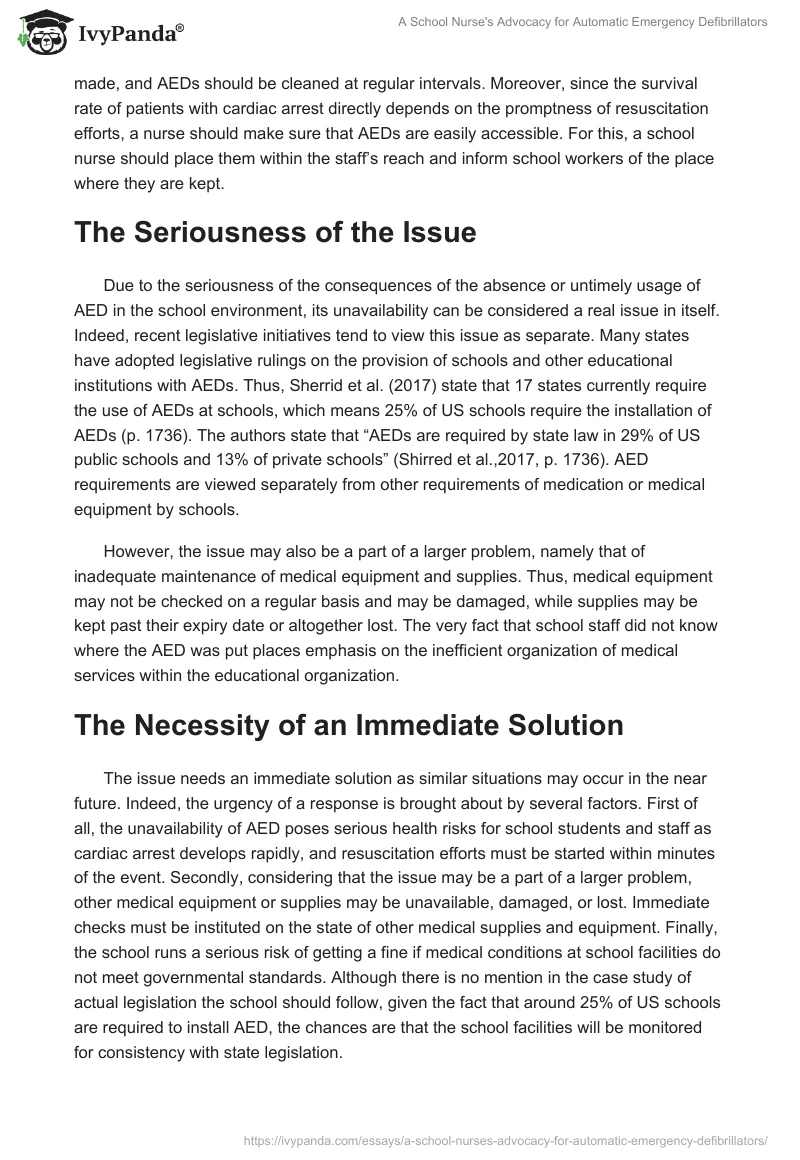Introduction
The issue of the availability of automatic emergency defibrillators (AED) is quite relevant for the school environment since their usage allows for a significant reduction in the number of deaths from cardiac arrest at school facilities. Studies show that “overall survival rates for children in schools without AEDs or action plans were a low 10% while schools with automated external defibrillators (AEDs) and cardiac emergency response plans (CERPs) had a nearly 70% survival rate (Saberian et al., 2018, p. 3). Apart from the physical availability of AED at school facilities, appropriate cardiopulmonary resuscitation (CPR) training programs should be launched for the staff and pupils to help them cope with cardiac arrest issues.
The Issue
The described case dealt with the issue of the unavailability of AED when it was necessary for resuscitation efforts. The issue is of paramount importance since cardiac arrest can result in death within minutes, and there are no other ways to cope with this state effectively apart from AED usage. The success of resuscitation efforts depends not only on the availability of AEDs but also on the time that elapses between cardiac attest and the start of emergency defibrillator usage. Since cardiac arrest is likely to happen during physical exercise, it makes sense to place AEDs near sports facilities and school stadiums. Moreover, it should be open to access so that precious time is not wasted looking for it.
The Possibility of Finding the Solution
A school nurse is directly responsible for maintaining a healthy school environment and ensuring that the necessary medical equipment is in place. In this particular case, a school nurse must make sure that there are enough AED items for all school facilities and that they are kept in good order. For this, regular maintenance checks should be made, and AEDs should be cleaned at regular intervals. Moreover, since the survival rate of patients with cardiac arrest directly depends on the promptness of resuscitation efforts, a nurse should make sure that AEDs are easily accessible. For this, a school nurse should place them within the staff’s reach and inform school workers of the place where they are kept.
The Seriousness of the Issue
Due to the seriousness of the consequences of the absence or untimely usage of AED in the school environment, its unavailability can be considered a real issue in itself. Indeed, recent legislative initiatives tend to view this issue as separate. Many states have adopted legislative rulings on the provision of schools and other educational institutions with AEDs. Thus, Sherrid et al. (2017) state that 17 states currently require the use of AEDs at schools, which means 25% of US schools require the installation of AEDs (p. 1736). The authors state that “AEDs are required by state law in 29% of US public schools and 13% of private schools” (Shirred et al.,2017, p. 1736). AED requirements are viewed separately from other requirements of medication or medical equipment by schools.
However, the issue may also be a part of a larger problem, namely that of inadequate maintenance of medical equipment and supplies. Thus, medical equipment may not be checked on a regular basis and may be damaged, while supplies may be kept past their expiry date or altogether lost. The very fact that school staff did not know where the AED was put places emphasis on the inefficient organization of medical services within the educational organization.
The Necessity of an Immediate Solution
The issue needs an immediate solution as similar situations may occur in the near future. Indeed, the urgency of a response is brought about by several factors. First of all, the unavailability of AED poses serious health risks for school students and staff as cardiac arrest develops rapidly, and resuscitation efforts must be started within minutes of the event. Secondly, considering that the issue may be a part of a larger problem, other medical equipment or supplies may be unavailable, damaged, or lost. Immediate checks must be instituted on the state of other medical supplies and equipment. Finally, the school runs a serious risk of getting a fine if medical conditions at school facilities do not meet governmental standards. Although there is no mention in the case study of actual legislation the school should follow, given the fact that around 25% of US schools are required to install AED, the chances are that the school facilities will be monitored for consistency with state legislation.
Likelihood That the Issue Goes Away by Itself
The issue is highly unlikely to go away by itself without proper monitoring. Since a school nurse is directly responsible for the proper maintenance and installation of medical equipment, no one else will assume these responsibilities. The only chance for the situation to be resolved without a nurse’s involvement is the arrival of a state monitoring group that would give an assessment of AED installation and usage. Given the fact of AED improper placement and keeping, in this case, the nurse runs the risk of being fired from the job.
The Risk of Ignoring the Issue
A nurse cannot risk ignoring it since the issue of improper AED placement poses serious health risks for school pupils and staff. In case cardiac arrest ends in the death of a child, a nurse may face charges of improper services that led to the death of a pupil. Moreover, the nurse runs the risk of losing her job and certification.
The Possible Solutions and Related Risks
One possible solution is the placement of AEDs next to sports facilities within the reach of the staff, as cardiac arrest is more likely to happen during sports activities. The other solution is keeping AED in a medical room and providing the keys to it to people responsible for school maintenance on different shifts. The third solution comprises providing school facilities with an adequate number of AEDs so that they can be put in all key locations at school facilities.
Whatever solution is chosen, it must necessarily be complemented by cardiopulmonary resuscitation (CPR) training among the staff. Blanchard et al. (2022) state that “the most commonly identified perceived barriers to effective AED use were insufficient training” or no training after AED acquisition (para. 8). Among other barriers, researchers name “cost, staff participation/support, maintenance, lack of policy, and school nurse performance fear” (Boudreaux & Broussard, 2020, p. 3). Berger (2020) sees as possible challenges “cost-effectiveness questions, liability concerns, ongoing upkeep and expenses, medical direction and school employee time and commitment” (p. 645). The possible risks involved in the proposed solution are theft or damage to AEDs if they are put in places easily accessible by everyone.
Steps Needed for Solution
In order to solve the issue, the program of AED implementation will have to be elaborated. First of all, the costs of acquiring additional AEDs, as well as the costs of cardiopulmonary resuscitation (CPR) training among the staff, will have to be assessed and presented to school management. Once approved, AEDs will be bought, training programs will be scheduled, and maintenance programs will have to be elaborated. Maintenance presupposes regular check-ups of AEDs and repetition of CPR training once in several years.
Does anyone else at the school need to be involved in the solution?
School staff and management will necessarily need to be involved in the solution. School management must see to it that the school has resources to finance the program. School staff are to undergo regular cardiopulmonary resuscitation training to be able to cope with cardiac arrest issues if the need arises. Moreover, school staff will have to be informed about where the automatic emergency defibrillator (AED) is kept and how to access it.
The Power Leverage in the School to Reach the Preferred Solution
The Use of Power Vested in the Nurse
In this situation, a nurse has a legitimate and information power. A legitimate power of a nurse lies in the fact that she has the position that presupposes control over the keeping and maintenance of medical equipment, in particular, AED. Thus, it is within a nurse’s powers to determine the number of AEDs needed, the appropriate places for their keeping, and the educational programs necessary to teach the staff to use AEDs effectively in emergency situations. The information power of a nurse lies in the fact that she is likely to be the only person with medical education in the staff and thus has the authority over medical matters others do not possess. In particular, a nurse can provide competent advice on cardiopulmonary resuscitation (CPR) training and its benefits and decide how many workers should take part in it.
The Solution Reached and the Rational for It
The optimal solution would be to provide school facilities with an adequate number of AEDs so that they can be put in all key locations, among which are sports facilities and recreation areas. However, the realization of this solution largely depends on the school’s budget since acquiring a certain number of AEDs may be rather expensive. If the school cannot finance the acquisition of many AEDs, then the optimal solution would be to place AEDs next to sports facilities within the reach of the staff. Both solutions will have to be combined with a cardiopulmonary resuscitation (CPR) training program to allow the staff to get the necessary skills to fight cardiac arrest effectively.
Alternative Solutions
While there is no alternative solution to placing AEDs within the reach of the staff, there are options in the education programs used for staff training. Thus, Kiyohara et al. (2019) suggest that resuscitation training programs should necessarily be complemented by emergency response plans (CERPs) that outline the sequence of actions in situations of cardiac arrest. Boudreaux and Broussard (2020) speak about an emergency action plan (EAP) that increases the survival rate of children suffering from cardiac arrest.
Conclusion
The issue of sudden cardiac arrest at schools has not lost its relevancy, which is why new measures continue to be developed to grapple with the problem. Specialists agree that the installation of AEDs at school facilities and their placement near sports and recreation centers within reach of the staff allows for an increase in the survival rates among children who suffer from cardiac arrest. Other measures comprised organizing cardiopulmonary resuscitation (CPR) training programs for the staff. The combination of such programs with CERPs or EAP improves the prognosis for people suffering from cardiac arrest.
References
Berger, S. (2020). CPR and AEDs save lives: insuring CPR–AED education and CPR–AED access in schools. Current opinion in pediatrics, 32(5), 641-645.
Blanchard, P. G., Graham, J. M., Gauvin, V., Lanoue, M. P., Péloquin, F., Bertrand, I.,… & Mercier, E. (2022). Reducing barriers to optimal automated external defibrillator use: an elementary school intervention study. CJC Pediatric and Congenital Heart Disease, 1(1), 30-36. Web.
Boudreaux, S., & Broussard, L. (2020). School Nurses’ Perceived Barriers and Perceptual Influences When Implementing AED Programs. The Journal of School Nursing, 36(3), 187-192. Web.
Kiyohara, K., Sado, J., Kitamura, T., Ayusawa, M., Nitta, M., Iwami, T.,… & Kitamura, Y. (2019). Public-access automated external defibrillation and bystander-initiated cardiopulmonary resuscitation in schools: a nationwide investigation in Japan. EP Europace, 21(3), 451-458. Web.
Saberian, S., Pendyala, V. S., Siebert, V. R., Himmel, B. A., Wigant, R. R., Knepp, M. D.,… & Baman, T. S. (2018). Disparities regarding inadequate automated external defibrillator training and potential barriers to successful cardiac resuscitation in public school systems. The American Journal of Cardiology, 122(9), 1565-1569. Web.
Sherrid, M. V., Aagaard, P., Serrato, S., Arabadjian, M. E., Lium, J. M., Lium, J. D., & Greenberg, H. M. (2017). State requirements for automated external defibrillators in American schools: framing the debate about legislative action. Journal of the American College of Cardiology, 69(13), 1735-1743. Web.


